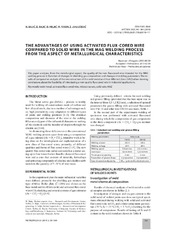Приказ основних података о документу
The advantages of using activated flux-cored wire compared to solid wire in the mag welding process from the aspect of metallurgical characteristics
| dc.creator | Bajić, N. | |
| dc.creator | Bajić, D. | |
| dc.creator | Veljić, Darko | |
| dc.creator | Rakin, Marko | |
| dc.creator | Janjusević, Z. | |
| dc.date.accessioned | 2021-03-10T12:35:41Z | |
| dc.date.available | 2021-03-10T12:35:41Z | |
| dc.date.issued | 2014 | |
| dc.identifier.issn | 0543-5846 | |
| dc.identifier.uri | http://TechnoRep.tmf.bg.ac.rs/handle/123456789/2844 | |
| dc.description.abstract | This paper analyzes, from the metallurgical aspect, the quality of the new flux-cored wire intended for the MAG welding process in function of changes in shielding gas composition and changes in welding parameters. The results of comparative analysis of the microstructure of the weld metal and Heat Affected Zone (HAZ) allow drawing conclusions about the feasibility of introducing a new quality flux-cored wire in industrial applications. | en |
| dc.publisher | Croatian Metallurgical Soc, Zagreb | |
| dc.relation | info:eu-repo/grantAgreement/MESTD/Technological Development (TD or TR)/34016/RS// | |
| dc.relation | info:eu-repo/grantAgreement/MESTD/Basic Research (BR or ON)/174004/RS// | |
| dc.relation | info:eu-repo/grantAgreement/MESTD/Technological Development (TD or TR)/35002/RS// | |
| dc.rights | openAccess | |
| dc.rights.uri | https://creativecommons.org/licenses/by/4.0/ | |
| dc.source | Metalurgija | |
| dc.subject | weld metal | en |
| dc.subject | activated flux-cored wire | en |
| dc.subject | microstructure | en |
| dc.subject | solid wire | en |
| dc.subject | HAZ | en |
| dc.title | The advantages of using activated flux-cored wire compared to solid wire in the mag welding process from the aspect of metallurgical characteristics | en |
| dc.type | article | |
| dc.rights.license | BY | |
| dc.citation.epage | 364 | |
| dc.citation.issue | 3 | |
| dc.citation.other | 53(3): 361-364 | |
| dc.citation.rank | M22 | |
| dc.citation.spage | 361 | |
| dc.citation.volume | 53 | |
| dc.identifier.fulltext | http://TechnoRep.tmf.bg.ac.rs/bitstream/id/918/2841.pdf | |
| dc.identifier.rcub | https://hdl.handle.net/21.15107/rcub_technorep_2844 | |
| dc.identifier.wos | 000333788700020 | |
| dc.type.version | publishedVersion |

